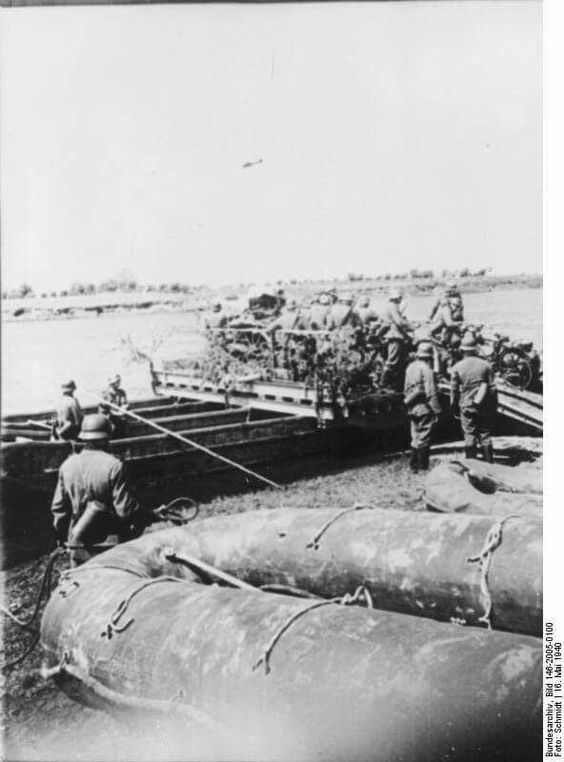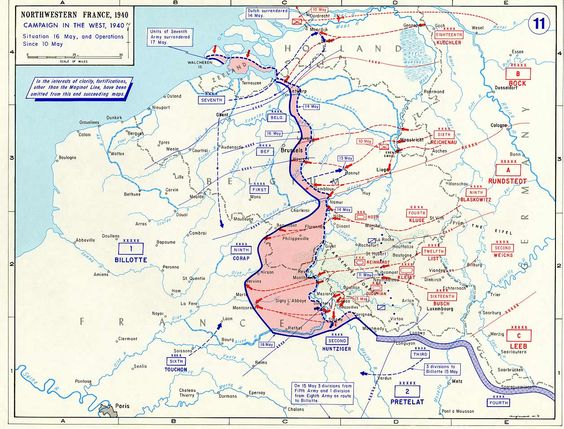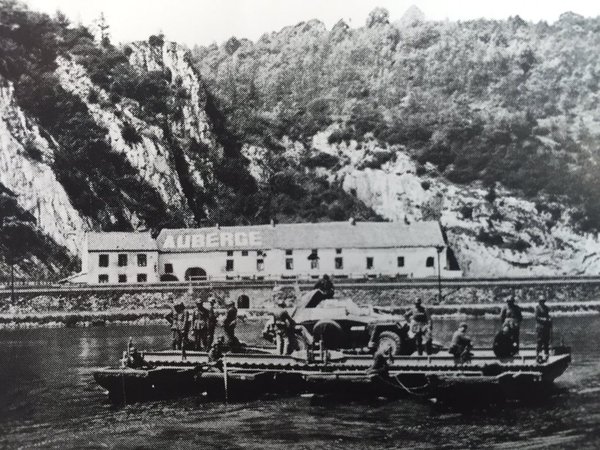Thursday 16 May 1940
 |
| Germans crossing the Meuse on 16 May 1940 (Schmidt, Federal Archive). |
Following a disastrous meeting with British Prime Minister Churchill (see below), French Prime Minister Paul Reynaud replaces General Gamelin with General Weygand - who is unfamiliar with the condition of the campaign and must fly up from Syria.
The Wehrmacht is moving with lightning speed. The Blitzkrieg is at its height, with the Luftwaffe blazing a trail for fast mobile forces. The speed of the panzers is preventing a coherent Allies response. Nobody really knows where the front is from hour to hour, and this prevents effective counter-measures. French attempts to counter-attack are hampered by refugees clogging the roads, an inability to know precisely where the Germans are, and roads littered with the destruction already caused by the German panzers, artillery, and Luftwaffe.
In France, "Fast Heinz" Guderian is now 60 miles west of Sedan, at Montcornet and around St. Quentin. General Hoth has his XV Panzer Corps, led by Erwin Rommel's 7th Panzer Division, a little further north in the Avesnes-sur-Helpe/Cambrai vicinity. As part of his move forward, Rommel's panzers serendipitously cut through the French 5th Motorised Infantry Division which is conveniently bivouacked on both sides of the very road that Rommel is using. Rommel destroys the French unit, leaving it with just 3 tanks as it retreats in disarray.
The Germans are also waging a campaign against the Maginot Line. Around mid-day, the artillery of the 71st Infantry Division begins shelling the town of Villy and a fortress of the Line that overlooks it called La Ferté.
In Belgium, the Allies retreat from the Dyle Line to a new line on the Scheldt River, which was their jumping-off point before springing forward to the Dyle Line. This effectively abandons Belgium to the Wehrmacht.
At Gembloux, the day's battle ends in a tactical stalemate, but a strategic victory for the Germans. The French line is never pierced and they batter the attacking Germans, but the deteriorating situation west of Sedan imperils the Allied lines of communication. At dusk, the French are ordered back to the French border to protect their own flanks. The failure to finish off the French today, though, has huge negative consequences in the coming weeks for the Germans.
 |
| Map noting German advances in France and the Low Countries between 10 and 16 May 1940. (US Military Academy). |
The Royal Navy sends the carrier Furious to Norway to ferry Gladiator and Hurricane fighters.
German raider Widder meets supply ship Nordmark to refuel.
Troop convoy US 2 from Australia brings the 17th Infantry Brigade to Egypt.
Convoy OA 149 departs from Southend, Convoy OB 149 departs from Liverpool, Convoy OG 30F forms at Gibraltar, and Convoy HX 43 departs from Halifax.
European Air Operations: France sends 26 of its brand new LeO 451 second-generation bombers against the panzers refueling at Montcornet. They lose four of their number.
The RAF moves its bases from near the Meuse closer to Paris, near Troyes at Anglure.
Anglo/French Relations: Winston Churchill flies to Paris to consult with Prime Minister Paul Reynaud, Defense Minister Daladier and General Gamelin. In his memoirs, Churchill recalls that he asked Gamelin at this meeting, first in English and then in French, “Where is the strategic reserve?” (“Où est la masse de manoeuvre?”). Gamelin simply replied, “Aucune!” ("There is none"). This led Reynaud to replace Gamelin with Weygand.
Churchill also notes: "In the garden of the Quai d'Orsay I see venerable officials burning secret documents. Already evacuation of Paris is being prepared." It is a common scene in European capitals recently.
Anglo/American Relations: President Roosevelt responds to Prime Minister Churchill's shopping list of 14 May. He notes that he will require "specific authorization of the Congress" for some of the requests and that he will keep the US fleet at Hawaii "at least for the time being."
US Government: President Roosevelt addresses a joint session of Congress. He establishes a target of 50,000 military aircraft a year. This appears from all experience to be an unreachable goal. He requests a total of $900,000,000 appropriation to fund this project. His individual requests include $546 million for the Army, $250 million for the Navy/Marine Corps, and $100 million for the Executive branch to handle contingencies. These are all unheard-of amounts of money.
Ireland: The Irish government, which has been maintaining strict neutrality, requests arms from the British government to equip the Irish Army.
Holocaust: In Occupied (rump) Poland, Gauleiter Hans Frank orders arrest and execution of Polish political, professional and religious leaders.
China: At the Battle of Tsaoyang-Ichang, the commander of the Chinese 33rd Army Group of the Chinese 5th War Area, General Chang Tze-Chung, is killed in action as his troops recapture Tsaoyang.
 |
| Germans crossing the Meuse, 16 May 1940 (Ang, Federal Archive). |
May 1940
May 1, 1940: British Leave ÅndalsnesMay 2, 1940: British Depart Namsos
May 3, 1940: Many Norwegians Surrendering
May 4, 1940: Bader Returns
May 5, 1940: HMS Seal Survives
May 6, 1940: Allies Focus on Narvik
May 7, 1940: In The Name of God, Go!
May 8, 1940: Exit Chamberlain
May 9, 1940: Enter Churchill
May 10, 1940: Fall Gelb
May 11, 1940: Eben Emael Surrenders
May 12, 1940: Germans at Sedan
May 13, 1940: Rommel at Work
May 14, 1940: German Breakout in France
May 15, 1940: Holland Surrenders
May 16, 1940: Dash to the Channel
May 17, 1940: Germans Take Brussels
May 18, 1940: Germans Take Antwerp
May 19, 1940: Failed French Counterattack
May 20, 1940: Panzers on the Coast
May 21, 1940: Battle of Arras
May 22, 1940: Attacking Channel Ports
May 23, 1940: British Evacuate Boulogne
May 24, 1940: Hitler's Stop Order
May 25, 1940: Belgian Defenses Creaking
May 26, 1940: Operation Dynamo
May 27, 1940: King Leopold Surrenders
May 28, 1940: The Allies Take Narvik
May 29, 1940: Lille Falls
May 30, 1940: Operation Fish
May 31, 1940: Peak Day for Dynamo
2020




